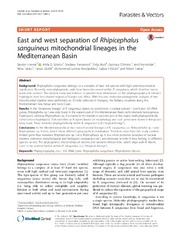| dc.creator | Hornok, Sandor | |
| dc.creator | Sandor, Attila D. | |
| dc.creator | Tomanović, Snežana | |
| dc.creator | Beck, Relja | |
| dc.creator | D'Amico, Gianluca | |
| dc.creator | Kontschan, Jeno | |
| dc.creator | Takacs, Nora | |
| dc.creator | Gorfol, Tamas | |
| dc.creator | Bendjeddou, Mohammed Lamine | |
| dc.creator | Foldvari, Gabor | |
| dc.creator | Farkas, Robert | |
| dc.date.accessioned | 2021-04-20T12:53:57Z | |
| dc.date.available | 2021-04-20T12:53:57Z | |
| dc.date.issued | 2017 | |
| dc.identifier.issn | 1756-3305 | |
| dc.identifier.uri | http://rimi.imi.bg.ac.rs/handle/123456789/802 | |
| dc.description.abstract | Background: Rhipicephalus sanguineus belongs to a complex of hard tick species with high veterinary-medical significance. Recently, new phylogenetic units have been discovered within R. sanguineus, which therefore needs taxonomic revision. The present study was initiated to provide new information on the phylogeography of relevant haplotypes from less studied regions of Europe and Africa. With this aim, molecular-phylogenetic analyses of two mitochondrial markers were performed on 50 ticks collected in Hungary, the Balkans, countries along the Mediterranean Sea, Kenya and Ivory Coast. Results: In the "temperate lineage" of R. sanguineus, based on cytochrome c oxidase subunit 1 (cox1) and 16S rRNA genes, Rhipicephalus sp. I was only found in the eastern part of the Mediterranean Basin (with relatively homogenous haplotypes), whereas Rhipicephalus sp. II occurred in the middle-to-western part of this region (with phylogenetically dichotomous haplotypes). Ticks identified as R. leporis (based on morphology and cox1 gene) were found in Kenya and Ivory Coast. These clustered phylogenetically within R. sanguineus (s.l.) ("tropical lineage"). Conclusions: In the Mediterranean Basin two mitochondrial lineages of R. sanguineus, i. e. Rhipicephalus sp. I and Rhipicephalus sp. II exist, which show different geographical distribution. Therefore, data from this study confirm limited gene flow between Rhipicephalus sp. I and Rhipicephalus sp. II, but more evidence (analyses of nuclear markers, extensive morphological and biological comparison etc.) are necessary to infer if they belong to different species or not. The phylogenetic relationships of eastern and western African ticks, which align with R. leporis, need to be studied further within R. sanguineus (s.l.) ("tropical lineage"). | en |
| dc.publisher | Biomed Central Ltd, London | |
| dc.relation | OTKA (Hungary)Orszagos Tudomanyos Kutatasi Alapprogramok (OTKA) [115854] | |
| dc.relation | Hungarian Academy of Sciences | |
| dc.relation | Hungarian Ministry of Human Resources [11475-4/2016/FEKUT] | |
| dc.relation | info:eu-repo/grantAgreement/MESTD/Basic Research (BR or ON)/173006/RS// | |
| dc.relation | [PN-II-RU-TE-2014-4-1389] | |
| dc.relation | [GENOTICKTRECK-1957] | |
| dc.rights | openAccess | |
| dc.rights.uri | https://creativecommons.org/licenses/by/4.0/ | |
| dc.source | Parasites & Vectors | |
| dc.subject | Phylogeography | en |
| dc.subject | cox1 | en |
| dc.subject | 16S rRNA gene | en |
| dc.subject | Rhipicephalus sanguineus | en |
| dc.subject | Rhipicephalus leporis | en |
| dc.title | East and west separation of Rhipicephalus sanguineus mitochondrial lineages in the Mediterranean Basin | en |
| dc.type | article | |
| dc.rights.license | BY | |
| dc.citation.other | 10: - | |
| dc.citation.rank | aM21 | |
| dc.citation.volume | 10 | |
| dc.identifier.doi | 10.1186/s13071-017-1985-z | |
| dc.identifier.fulltext | http://rimi.imi.bg.ac.rs/bitstream/id/615/799.pdf | |
| dc.identifier.pmid | 28115024 | |
| dc.identifier.scopus | 2-s2.0-85010901239 | |
| dc.identifier.wos | 000396326200001 | |
| dc.type.version | publishedVersion | |

